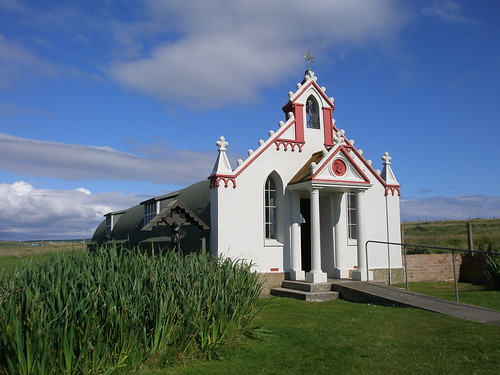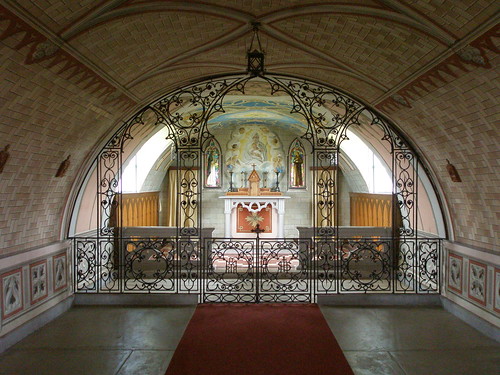Here’s the first of two exclusive online extracts from the indispensable guide to the hidden joys of Scotland, Anne Ward’s Nothing to See Here. It’s published by the intrepid folks at Pocket Mountains and you can buy it here. Today, we marvel at an inspiring hand-crafted chapel.
In the waters of Scapa Flow, the rusting hulks of scuttled German warships are a stark reminder of the important part that Orkney played in World War II. Beside them on the small island of Lamb Holm, the Italian Chapel is a symbol of the lasting peace.
The chapel and statue of St George that sits beside it are the only remaining pieces of Camp 60, a prisoner of war camp which held several hundred Italian prisoners from 1942 to 1944. The men, who were experienced tradesmen, spent their days building the Churchill Barriers, the causeways built as naval defences linking the islands of Orkney’s mainland.
In their spare time, the men worked on making the camp a home from home. Their Catholic faith was vital to them so they negotiated the use of two Nissen huts for a small chapel. Decorative materials were in short supply so it was a case of ‘make do and mend’ to turn this into somewhere fit for prayer.
Electricians, plasterers and smiths all played their part. Domenico Chiocchetti, one of the more artistic prisoners, set to work painting the chapel taking inspiration from the finest Italian churches. Armed with a Christmas card from his mother featuring the painting, Madonna of the Olives by Nicolo Barabina he created a fresco of the Madonna and Child above the altar. The cherub on the bottom left holds a blue shield, a symbol of Chiocchetti’s home town, Moena. The sanctuary
vault was painted with the symbols of the four evangelists, with a white dove (symbolising the Holy Spirit) in the centre.
The fittings were made from found materials – an altar and holy water stoop from concrete and candelabras made from salvaged iron and brass. Wood from a wrecked ship became the tabernacle. The chancel was then so surprisingly delicate that an iron rood screen was commissioned to finish it off. After that, the rest of the building really had some catching up to do so Chiocchetti’s simple but brilliant idea was to paint the interior to look like decorative brickwork – so well done you have to stroke it just to make sure it isn’t real.
With the interior complete the next task was to disguise the exterior, still unmistakeably a humble Nissen hut. A bright white plasterwork facade was topped by a belfry with Gothic pinnacles on either side. Initially the bell was a cardboard one, until a ship’s one was found to replace it. The transformation was so remarkable that when the other prisoners left in September 1944 Chiocchetti was allowed to stay behind to finish the last few details. When it was finally complete a small party was held to the soundtrack of the bells of St Peter’s in Rome playing on a gramophone.
After the war ended the camp was dismantled and over the years the condition of the chapel began to deteriorate. In 1958 concerned Orcadians established a preservation committee and two years later a piece on BBC radio broadcast in Italy brought Ciocchetti back over from Moena to touch up his artwork. Links between Orkney and Moena continue to this day, with great affection on both sides. The chapel was restored again in the 1990s and is admired by visitors from all over the world as a remarkable place of faith and friendship.
(You can find more photos here, Ed.).










This reads like a happier version of Bridge Over the River Kwai. I love the twin-town-ing that ensued.
I first visited this about fifteen years ago. It’s quietly splendid and fits surprisingly well into the landscape..